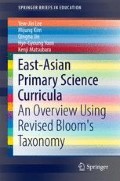Abstract
Analyzing cognitive demands in a curriculum can map out what children are expected to learn and be able to do throughout their period of formal schooling. The question now is which tools are available or effective to analyze the dimensions and types of knowledge/skills required to teach/learn in schools.
Access this chapter
Tax calculation will be finalised at checkout
Purchases are for personal use only
Notes
- 1.
These four dimensions of knowledge and six cognitive processes will be in capitals throughout this book. Thus, for example, we will simply state that an item is in Conceptual without attaching the word “category” after it.
References
Anderson, L. W., & Sosniak, L. A. (Eds.). (1994). Bloom’s taxonomy: A forty-year retrospective. Ninety-third yearbook of the National Society for the Study of Education. Part II. Chicago, Il: The University of Chicago Press.
Anderson, L. W., Krathwohl, D. R., Airasian, P. W., Cruikshank, K. A., Mayer, R. E., Pintrich…Wittrock, M. C. (Eds.). (2001). A taxonomy for learning, teaching and assessing. A revision of Bloom’s taxonomy of educational objectives. White Plains, NY: Addison-Wesley Longman.
Ari, A. (2011). Finding acceptance of Bloom’s revised cognitive taxonomy on the international stage and in Turkey. Educational Sciences: Theory and Practice, 11, 767–772.
Biggs, J. (1995). Assessing for learning: Some dimensions underlying new approaches to educational assessment. The Alberta Journal of Educational Research, 41, 1–17.
Bloom, B. S. (1994). Reflections of the development and use of the Taxonomy. In L. W. Anderson, & L. S. Sosniak (Eds.), Bloom’s taxonomy: A forty-year retrospective. Ninety-third yearbook of the National Society for the Study of Education. Part II (pp. 1–8). Chicago, Il: The University of Chicago Press.
Bloom, B. S., Engelhart, M. D., Furst, E.J., Hill, W.H., & Krathwohl, D., R. (1956). Taxonomy of educational objectives: The classification of educational goals. Handbook I: Cognitive domain. New York: David McKay.
Brabrand, C., & Dahl, B. (2009). Using the SOLO taxonomy to analyze competence progression of university science curricula. Higher Education, 58, 531–549.
Chung, D. H., Lee, J.-K., Kim, S. E., & Park, K. J. (2013). An analysis on congruency between educational objectives of curriculum and learning objectives of textbooks using semantic network analysis-focus on Earth Science I in the 2009 revised curriculum. Journal of the Korean Earth Science Society, 34, 711–726.
Holliday, W. G., & Cain, S. D. (2012). Teaching science reading comprehension: A realistic, research-based approach. In B. Fraser, K. Tobin, & C. McRobbie (Eds.), Second international handbook of science education (pp. 1405–1417). Dordrecht: Springer.
Klopfer, L. E. (1971). Evaluation of learning in science. In B. S. Bloom, J. T. Hastings, & G. F. Madsus (Eds.), Handbook on formative and summative evaluation of students learning. NY: McGraw-Hill.
Krathwohl, D. R. (2002). A revision of Bloom’s taxonomy: An overview. Theory into Practice, 41, 212–264.
Marzano, R. J. (2000). Designing a new taxonomy of educational objectives. Thousand Oaks, CA: Corwin Press.
Marzano, R. J., & Kendall, J. S. (Eds.). (2007). The new taxonomy of educational objectives. Thousand Oaks, CA: Corwin Press.
Porter, A. C. (2006). Curriculum assessment. In J. L. Green, G. Camilli, & P. B. Elmore (Eds.), Handbook of complementary methods in education research (pp. 141–159). Mahwah, NJ: Lawrence Erlbaum.
Schneider, J. (2014). From the ivory tower to the schoolhouse: How scholarship becomes common knowledge in education. Cambridge, MA: Harvard Education Press.
Wee, S.-M., Kim, B.-K., Cho, H., Sohn, J., & Oh, C. (2011). Comparison of instructional objectives of the 2007 revised elementary science curriculum with 7th elementary curriculum based on Bloom’s revised taxonomy. Journal of Korean Elementary Science Education, 30, 10–21.
Author information
Authors and Affiliations
Corresponding author
Rights and permissions
Copyright information
© 2017 The Author(s)
About this chapter
Cite this chapter
Lee, YJ., Kim, M., Jin, Q., Yoon, HG., Matsubara, K. (2017). Revised Bloom’s Taxonomy—The Swiss Army Knife in Curriculum Research. In: East-Asian Primary Science Curricula. SpringerBriefs in Education. Springer, Singapore. https://doi.org/10.1007/978-981-10-2690-4_2
Download citation
DOI: https://doi.org/10.1007/978-981-10-2690-4_2
Published:
Publisher Name: Springer, Singapore
Print ISBN: 978-981-10-2689-8
Online ISBN: 978-981-10-2690-4
eBook Packages: EducationEducation (R0)

